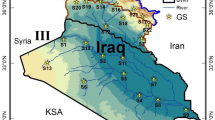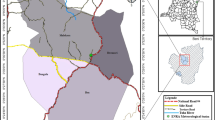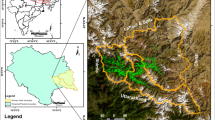Abstract
Precipitation is a major climatic element with high spatial variations. Temporal and spatial variations may differ in large and small scales. It is, therefore, of utmost importance to study areas with similar gradients in terms of precipitation patterns in order to shed light on the complexities of precipitation variations. In the present study, attempts were made to identify areas with similar gradients experiencing the same precipitation pattern over a 50-year period (1964–2013). To this end, data were collected from synoptic stations in Iran in two phases (i.e., 1434 stations in the first phase and 673 stations in the second one). Alexanderson’s technique was adopted to examine sudden changes in precipitation patterns. The results showed that five regions with similar gradients could be identified in terms of precipitation patterns: negative and high variations, negative and moderate variations, positive and high variations, positive and moderate variations, and little or no variations. The distribution of such regions indicated that the regions with positive trends experienced more annual variations and had further spatial distribution. Furthermore, the findings revealed that the regions with negative precipitation patterns experienced more sudden changes in comparison with those with positive precipitation patterns. Additionally, more variations were observed in the precipitation patterns in recent years.




Similar content being viewed by others
References
Ajaaj AA, Mishra AK, Khan AA (2018) Urban and peri-urban precipitation and air temperature trends in mega cities of the world using multiple trend analysis methods. Theor Appl Climatol 2:403–418
Akinremi OO, Ginnotes MM, Cutforth HW (2001) Seasonal and spatial patterns of rainfall trend on the Canadian prairies. J Clim 14:2177–2182
Albert P, Osetinsky I, Ziv B, Safir H (2004) Semi- objective classification for daily synoptic systems: application to the eastern climate change. J Climatol 24:1001–1011
Alexandersson H (1995) Homogeneity testing, multiple breaks and trends. Preprints, Proc. 6th Int. Meeting on Stat. Climatology, Galway, Ireland, p 439-441
Asakereh H (2007) Spatial – temporal changes of Iran inland precipitation during recent decades. Geogr Dev 10:145–164 (In Persian)
Asakereh H, Doostkamian M (2014) Tempo-spatial changes of perceptible water in the atmosphere of Iran. Iran Water Resour Res 1:72–86 (In Persian)
Asakereh H, Doostkamian M (2017) Investigation the pattern of similar gradient regions of average annual temperature changes of Iran. Geogr Dev 41:149–162 (In Persian)
Brunetti M, Buffoni L, Maugeri M, Nanni T (2000) Precipitation intensity trends in northern Italy. Int J Climatol 9:1017–1031
Chadwick R, Good P, Andrews T, Martin G (2014) Surface warming patterns drive tropical rainfall pattern responses to CO2 forcing on all timescales. Geophys Res Lett 41:610–615
Chaouche K, Neppel L, Dieulin C, Pujol N, Ladouche B, Martin E, Salas D, Caballero Y (2010) Analyses of precipitation, temperature and evapotranspiration in a French Mediterranean region in the context of climate change. Compt Rendus Geosci 342:234–243
Clark JS, Yiridoe EK, Burns ND, Astatkie T (2000) Regional climate change: trend analysis of temperature and precipitation series at selected Canadian sites. Can J Agr Econ 48:27–38
Darabi H, Jafari A, Akhavan Farshchi K (2016) Climate change analysis and its’ impacts in Qom Province, Iran. J Environ Sci Study 1:25–40 (In Persian)
Darand M, Doostkamian M, Rehmani MIA (2017) Spatial autocorrelation analysis of extreme precipitation in Iran. Russ Meteorol Hydrol 42(6):415–424
Darand M, Doulatyari Z, Aslani Eslmerz F, Azizi Y (2014) The investigation of extreme precipitation and temperature behavior in kermanshah by statistic tests. J Geog Space 46:195–215 (In Persian)
Darand M, Masoodian A, Nazaripour H, Daneshvar MM (2015) Spatial and temporal trend analysis of temperature extremes based on Iranian climatic database (1962–2004). Arab J Geosci 8(10):8469–8480
Darand M, Sohrabi MM (2018) Identifying drought-and flood-prone areas based on significant changes in daily precipitation over Iran. Nat Hazards 90:1427–1446
Dhorde A, Dhorde A, Gadgil S (2009) Long term temperature trends at four largest cities of India during twentieth century. J Indian Geophys 2:85–97
Feyzi V, Farajzadeh M, Nowroozi R (2010) Study of climate change in Sistan and Baluchestan province by man-Kendall method, Fourth International Congress of Geographers of the Islamic World, Zahedan, Sistan and Baluchestan University. https://www.civilica.coem/Paper-ICIWG04-ICIWG04_121.html
García J, Serrano A, De la Cruz Gallego M (2002) A spectral analysis of Iberian Peninsula monthly rainfall. Theor Appl Climatol 71:77–95
Ghahraman B, Taghvaeian S (2008) Investigation of annual rainfall trends in Iran. J Agric Sci Technol 10:93–97 (In Persian)
Hejam S, Khoshkho Y, Shamsaldin Vandi R (2008) Annual and seasonal precipitation trend analysis of some selective meteorological stations in central region of Iran using non-parametric methods. Physical Geography Research Quarterly 64:157–168 (In Persian)
Jhajharia D, Shrivastava SK, Sarka DR, Sarkar S (2009) Temporal characteristics of pan evaporation trends under the humid conditions of Northeast India. Agric For Meteorol 149:763–770
Kazemzadeh M, Malekian A, Moghaddamnia A, Khalighi Sigaroudi S (2017) Shift changes and heterogeneity analysis of hydro-climatic variables (a case study: Aji chai watershed). Iran J Ecohydrol 1:163–175
Lacombe G, McCartney M (2014) Uncovering consistencies in Indian rainfall trends observed over the last half century. Clim Chang 123(2):287–299
Massah Bavani A, Goodarzi E, Zohrabi N, Lotfi S (2013) Detection of temperature and precipitation trends and their attribution it to the greenhouse gases (case study: West Azerbaijan province). J Earth Space Phys 3:111–128 (In Persian)
Modarres R, de Paulo Rodrigues da Silva V (2007) Rainfall trends in arid and semiarid regions of Iran. J Arid Environ 70(In Persian):344–355
Mondal A, Kundu S, Mukhopadhyay A (2012) Rainfall trend analysis by Mann-Kendall test: a case study of north-eastern part of Cuttack district, Orissa. Int J Geol Earth Environ Sci 1:70–78
Nasrabadi E, Masoodian A, Asakereh H (2013) Comparison of gridded precipitation time series data in APHRODITE and Asfazari databases within Iran’s territory. Atmos Clim Sci 2:235–248
Nazaripour H, Mansouri Daneshvar MR (2014) Spatial contribution of one-day precipitations variability to rainy days and rainfall amounts in Iran. Int J Environ Sci 11(6):1751–1758
Overland JM, Percival BD, Mofjeld OH (2006) Short communication change in the Arcitic influence on Bering Sea climate during the twentieth century. Int J Climatol 26:531–539
Partal T, Kahya E (2006) Trend analysis in Turkish precipitation data. Hydrol Process 6:2011–2026
Piccarreta M, Capolongo D, Boenzi F (2004) Trend analysis of precipitation and drought in Basilicata from 1923 to 2000 within a southern Italy context. Int J Climatol 7:907–922
Prudhomme C, Reed DW (1999) Mapping extreme rainfall in a mountainous region using geostatistical techniques: a case study in Scotland. Int J Climatol 19:1337–1356
Qian WH, Lin X, Zhu YF, Xu Y, Fu JL (2007) Climatic regime shift and decadal anomalous events in China. Clim Chang 84:167–189. https://doi.org/10.1007/s10584-006-9234-z
Rahimzade F (2011) Evaluation of trend and mutation of temperature and precipitation indexes in Hormozgan province geography and development. Iran J 21:97–116 (In Persian)
Raziei T, Daneshkar Arasteh P, Saghfian B (2005) Annual rainfall trend analysis in arid and semiarid regions on central and eastern Iran. J Wat Soil Sci 54:73–81 (In Persian)
Sabohi R, Soltani S (2009) Trend analysis of climatic factors in great cities of Iran. J Wat Wast 46:303–321 (In Persian)
Siler N, Roe G (2014) How will orographic precipitation respond to surface warming? An idealized thermodynamic perspective. Geophys Res Lett 41:2606–2613
Soltani M, Laux P, Kunstmann H, Stan K, Sohrabi MM, Molanejad M, Sabziparvar AA, RanjbarSaadatAbadi A, Ranjbar F, Rousta I, Zawar-Reza P, Khoshakhlagh F, Soltanzadeh I, Babu CA, Azizi GH, Martin MV (2016) Assessment of climate variations in temperature and precipitation extreme events over Iran. Theor Appl Climatol 4:775–795
Soltani S, Saboohi R, Yaghmaei L (2012) Rainfall and rainy days trend in Iran. Clim Chang 2:187–213
Tonkaz T, Cetin M, Tulucu K (2007) The impact of water resources development projects on water vapor pressure trends in a semi-arid region, Turkey. J Clim Chang 82:195–209
Torfs JJF, Roulin E, van Deursen WPA (2007) Impact of climate change on low-flows in the river Meuse. Clim Chang 82:351–372
Toride K, Cawthorne DL, Ishida K, Kavvas ML, Anderson ML (2018) Long-term trend analysis on total and extreme precipitation over Shasta dam watershed. Sci Total Environ 626:244–254
Tošić I, Unkašević M (2005) Analysis of precipitation series for Belgrade. Theor Appl Climatol 80:67–77
Yue S, Hashino M (2003) Long term trends of annual and monthly precipitation in Japan. J Am Water Resour Assoc 39(3):587–559
Author information
Authors and Affiliations
Corresponding author
Rights and permissions
About this article
Cite this article
Asakereh, H., Darand, M. & Doostkamian, M. Analysis of pervasive precipitation in similar gradient areas of Iran. Arab J Geosci 11, 511 (2018). https://doi.org/10.1007/s12517-018-3873-z
Received:
Accepted:
Published:
DOI: https://doi.org/10.1007/s12517-018-3873-z




